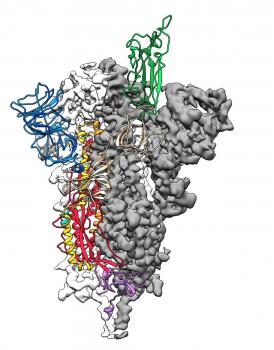In late 2019, the first report of an unknown respiratory infection, in some cases, fatal emerged from Wuhan, China. The sources of that infection were quickly identified as a novel coronavirus related to those that had caused an outbreak of Severe Acute Respiratory Syndrome (SARS) from 2002-2004 and Middle East Respiratory Syndrome (MERS) in 2012.
The World Health Organization was declared the illness resulting from the new virus, COVID-19, a Public Health Emergency of International Concerns. By early in March of 2020, the novel coronavirus now named SARS-CoV-2 had infected more than 90,000 people worldwide and killed at least 3,100.
Researchers have determined the first 3D atomic design scale map of the spike glycoprotein of the novel coronavirus (SARS-CoV-2). Mapped by Cryo-EM, this finding from teams at the University of Texas (UT) at Austin and the National Institutes of Health is an essential step to allow researchers to develop vaccines and antiviral drugs to combat the virus.
NIAID scientists working with investigators from the University of Texas at Austin (UT) identified the atomic structure of an essential protein on the surface of the novel coronavirus (SARS-CoV-2, formerly called 2019-nCoV). The findings seem within the peer-reviewed journal Science. The authors note that the findings will aid in the design of candidate vaccines and the development of treatments for COVID-19, the disease caused by the new virus, which was the first identified in China in December 2019.
Like other coronaviruses, SARS-CoV-2 particles are spherical and have mushroom-shaped proteins called spikes protruding from their surface, giving the particles a crown-like appearance. The spikes bind and fuse to humans cells, allowing the virus to gain entry. However, coronavirus infection can be prevented or slowed if this process is disrupted.
It is a 3D atomic-scale map of the SARS-CoV-2 spike protein. The protein takes on two different conformations before it infects a host cell, and another during infection. This structure represents the supermolecule before it infects a cell, referred to as the prefusion conformation.. [Jason McLellan/Univ. of Texas at Austin]
Scientists in China shared the genome of a SARS-CoV-2 virus isolates to a global database, which NIAID experts used to start their work determining the spike structure. The SpikeSpike undergoes a massive rearrangement as it fuses the virus and cell membranes. The researchers confirmed that the originals spike stabilized in its prefusion conformation is more likely to preserve targets for infection-blocking antibodies induced by vaccines.
Importantly, the new data support NIAID’s approach to a gene-based vaccine for COVID-19 and will also be useful in other vaccine approaches, including protein-based vaccines and other nucleic acid or vector-based delivery approaches. NIAID scientists designed the stabilized spike antigen based on previous knowledge obtained from studying other coronavirus spike structures. NIAID and the biotechnology company Modern, based on Cambridge, Massachusetts, are developing a messenger RNA vaccine, which directs the body’s cells to express the SpikeSpike in its prefusion conformation to elicit an immune response.
The new research also confirms that the structure of the SARS-CoV-2 SpikeSpike is very similar to that of the coronavirus responsible for the global outbreak of severe acute respiratory syndrome in 2003 that was eventually contained (known as SARS-CoV).
However, despite the similarities, the paper shows that some monoclonal antibodies developed to target SARS-CoV do not bind to the new coronavirus, indicating that antibodies that recognize the SARS-CoV from 2003 will not necessarily be effective in preventing or treating COVID-19, the disease caused by the new virus.
Recent reports show that the novel virus and SARS-CoV also bind to the same receptor on the host cell. However, NIAID and UT scientists determined that SARS-CoV-2 binds more easily to this receptor as compared to SARS-CoV, which could potentially explain why SARS-CoV-2 appears to spread more efficiently from human-to-human. However, more data is needed to investigate this possibility, the authors note.
This research was supported by the NIAID Intramural Research Program and an NIAID grant to the University of Texas at Austin (R01-AI127521).
Reference:
D. Wrap, N Wang et al. Cryo-EM structure of the 2019-Nov Spike in the Prefusion Conformation. Science DOI: 10.1126/science.abb2507 (2020)













No comments:
Post a Comment
If you have any doubts, please let me know.